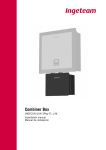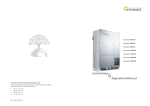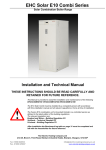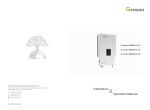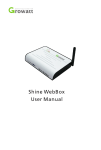Download Troubleshooting for 10-20kUE Three-Phase Inverter
Transcript
Troubleshooting for 10-20kUE Three-Phase Inverter Version Date Ver.1.0 2013.8.22 Note Content GENERAL .................................................................................................................................................................. - 1 TROUBLESHOOTING.................................................................................................................................................. - 3 WARNING ......................................................................................................................................................... - 3 - I WARNING 100 ......................................................................................................................................................... - 3 - WARNING 103 ......................................................................................................................................................... - 7 - WARNING 104 ......................................................................................................................................................... - 7 - WARNING 105 ......................................................................................................................................................... - 9 INVERTER FAULT ............................................................................................................................................... - 9 - II ERROR 101 ............................................................................................................................................................. - 9 - ERROR 107 ............................................................................................................................................................. - 9 - ERROR 117 ............................................................................................................................................................. - 9 - ERROR 121 ........................................................................................................................................................... - 10 - ERROR 122 ........................................................................................................................................................... - 10 - ERROR 104 ........................................................................................................................................................... - 10 - ERROR 119 ........................................................................................................................................................... - 10 SYSTEM FAULT .................................................................................................................................................- 10 - III AUTO TEST FAILED .................................................................................................................................................. - 10 - PV ISOLATION LOW ................................................................................................................................................. - 10 - PV VOLTAGE HIGH .................................................................................................................................................. - 12 - RESIDUAL I HIGH .................................................................................................................................................... - 13 - OUTPUT HIGH DCI ................................................................................................................................................. - 13 - AC V OUTRANGE.................................................................................................................................................... - 14 - AC F OUTRANGE .................................................................................................................................................... - 18 - ANNEX .....................................................................................................................................................................- 20 1. HOW TO CONNECT AC TERMINAL (DISCONNECT IN REVERSE ORDER) ................................................................................ - 20 - 2. HOW TO REPLACE CONTROL BOARD AND COM BOARD .................................................................................................. - 23 - CONTACT INFORMATION .........................................................................................................................................- 28 - GENERAL This document is applicable for Growatt 10000UE, 12000UE, 18000UE and 20000UE three-phase inverter. An error message will be displayed on the LCD screen while a fault occurs. The faults consist of inverter fault and system fault. All faults will shut down the inverter accompanied by red LED indicator immediately and wait until the fault is cleared. When a warning message is shown on LCD display, the inverter will continue working but will be accompanied by flash red LED indicator. You may be advised to contact Growatt in some situation, please provide the following information. Information concerning the inverter: Serial number Model number Error or warning message on LCD Short description of the problem Grid voltage DC input voltage Can you reproduce the failure? If yes, how? Has this problem occurred in the past? What was the ambient condition when the problem occurred? Information concerning the PV panels: Manufacturer name and model number of the PV panel Output power of the panel Voc of the panel Vmp of the panel Imp of the panel Number of panels in each string How many strings connected in one MPP tracker If it is necessary to replace the unit, please ship it in the original box. -1- Display On LCD Record Code Detailed content 100 Malfunction with the fan 103 Fail to read EEPROM 104 Firmware version unmatched 105 Fail to write EEPROM 101 Communication error, COM board(Slave CPU) doesn't receive from control board(Main CPU) over 10 seconds 107 Sampling difference is big 117 Relay fault , Relay check fails 6 times 121 Communication error, control board doesn't receive data from COM (communication) board over 5 seconds. 122 Bus voltage is too high 104 Model error 119 GFCI module check fails Auto Test Failed / Auto test didn’t pass. PV Isolation Low 125 PV input insulation impedance too low PV Voltage High 128 PV voltage is over 1000V Residual I High 126 Leakage current too high Output High DCI 127 Output DC current too high AC V Outrange 129 Grid voltage is out of range AC F Outrange 130 Grid frequency is out of range Warning e.g. LCD Shows “Warning 100” Error (Inverter Fault) e.g. LCD shows “Error 101” Fault (System Fault) Table 1.1.1 Fault and warning summary -2- TROUBLESHOOTING I Warning Warning 100 Malfunction with the fan 1. Turn off DC switch, rotate the fan blade with screwdriver, and then restart the inverter. Fig.2.1.1 2. If it is not easy to rotate the fan blade, check whether the fan is stuck by some obstructions. A. If fans or grills are just covered by soft dust particles, stones or snow lump, using tools such as vacuum cleaner to clean the fans. And if user has no such tools or there are obstructions in fans, grills or the cooling area of inverter, you need to clean the fans and grills after they are took apart from the inverter. Note: a. Growatt 10-20kUE three-phase inverter has two types of fan structures. b. Growatt 10kUE, 12kUE has two fans while 18KUE, 20KUE has three fans on the top of inverter. Fan type 1 cleaning procedure: The left and top of shell plane is as entirety seamlessly. 1) Before cleaning, please disconnect the DC and AC connection. Turn off the DC switch. Disconnect the DC terminal. (You might need some tool to disconnect the male and female terminals). Disconnect the AC terminal. 2) Remove the protection pedestals at the bottom of inverter. Remove the inverter from mounting bracket, and place inverter horizontally on clean and dry place. First of all you should remove the protection pedestals at the bottom of inverter as Fig.2.13 show. Use screwdrivers counterclockwise rotate the screws as figures shown below. -3- Fig.2.1.2 UE series inverter Fig.2.1.3 A View Fig.2.1.4 B View 3) Remove the handles on both sides of UE inverter as Fig.2.1.4 show. 4) Remove the shell plane of the bottom and right side. Use appropriate screwdrivers counterclockwise rotate the screws marked in Fig.2.1.5. Fig.2.1.5 5) Unlock and remove the plug connectors of cooling fans. To unlock the plug connectors, you need some tinny tools. There are 2 connectors, as Fig.2.1.6 show. -4- Fig.2.1.6 6) Remove the shell plane of the top and left side, as Fig.2.1.6 1 2 4 5 show. It’s easy to clean the grills on shell plane using water or some tools. 7) Clean the grills on shell planes. 8) Remove and clean the cooling fans. Unscrew and remove the cooling fans as Fig.2.1.7. Clean the cooling fans using appropriate tools such as brushes, clothes or water. Fig.2.1.7 9) After cleaning, assemble the inverter in reverse order. If you cleaning the fans with water make sure the fans, cables and connectors are dry before assembling. Fan type 2 cleaning procedure: There is only independent fan cover on the top of inverter. 1) Please disconnect the DC and AC connection. Turn off the DC switch. Disconnect the DC terminal. (You might need some tool to disconnect the male and -5- female terminals). Disconnect the AC terminal. 2) Remove the inverter from mounting bracket, and place inverter horizontally on clean and dry place. 3) Screw off the screws to open the fans cover with suitable tool, then fans will be seen, as Fig.2.1.8. Fig.2.1.8 4) Pull out the plug connectors with some tinny tools as Fig.2.1.9. Fig.2.1.9 5) Take away the fans from the cover and clean them thoroughly. Fig.2.1.10 -6- 6) After finishing cleaning, assemble back the fans in reverse order. B. If the fan is not stuck, check whether the fan is broken, especially motor bracket of fan is broken or not. Motor Bracket Fig.2.1.11 Cooling fan Fan replacement is required if it fails to work. The procedure is similar to fan cleaning procedure; the difference is that broken fan should be exchanging before assembling the inverter in reverse order. Please contact Growatt service to get new one if there are some broken fans in inverter. Warning 103 Fail to read EEPROM. 1. Please power off the inverter completely till there is nothing displayed on LCD and restart, observe whether the warning is cleared. 2. If the warning is not cleared, please refer step 9) in Annex 2 to reset the model value and serial number (S/N), and then restart the inverter for retry. 3. If the warning still exists, please refer Annex 2 to replace COM board and control board. Warning 104 Firmware version unmatched 1. Please register model name indicated on the data label beside inverter. -7- Fig.2.3.1 Data label 2. Please read the internal firmware version and model value by knock or via ShineBus, and register them as well. Model value External firmware version Fig.2.3.2 Property interface Fig.2.3.3 Internal FW Ver. on LCD Model value Firmware version Fig.2.3.4 State information on ShineBus 3. Provide above information to Growatt service. -8- Warning 105 Fail to write EEPROM. 1. Please power off the inverter completely till there is nothing displayed on LCD and restart, observe whether the warning is cleared. 2. If the warning still exists, please refer Annex 2 to replace COM board and control board. II Inverter Fault Error 101 Communication error, COM board doesn't receive data from control board over 10 seconds. 1. Please power off the inverter completely till there is nothing displayed on LCD and restart, observe whether the warning is cleaned. 2. If the warning is not cleared, please power off inverter and open the inverter cover to confirm the signal cable between control board and COM board shown in Fig.3.1.1 is connected well. Control board COM board Fig.3.1.1 Signal cable between COM and control board 3. If the error still exists, please refer Annex 2 to replace control board and COM board. Error 107 Sampling difference is big. 1. Restart the inverter, check if the error still exists. 2. If the error still exists, please refer Annex 2 to replace control board and COM board. 3. If the error still exists, please contact Growatt service to replace an inverter. Error 117 -9- Relay fault There is something wrong with the relay or its relevant circuit. Restart the inverter, if the error still exists, please contact Growatt service to replace the inverter. Error 121 Communication error, control board doesn't receive data from COM board over 5 seconds. 1. Please power off the inverter completely till there is nothing displayed on LCD and restart, observe whether the warning is cleared. 2. If the warning is not cleared, please power off inverter and open the inverter cover to confirm the signal cable between control board and COM board shown in Fig.3.1.1 is connected well. 3. If the error still exists, please refer Annex 2 to replace control board and COM board. Error 122 Bus voltage is too high. 1. Restart the inverter, and check whether the error still exists. 2. Turn off AC breaker, measure the voltage between PV+ to PV- by multi-meter and check whether it is within DC voltage range. If it is higher than the Max allowed DC voltage 1000V, you need to reduce the quantity of PV modules. 3. Update the firmware of control board to version 0D37 or above, and COM board to version 0C30 or above. Error 104 Model error Update the firmware of control board to version 0D37 or above, and COM board to version 0C30 or above. Error 119 GFCI module check fails Update the firmware of control board to version 0D37 or above, and COM board to version 0C30 or above. III System Fault Auto Test Failed The auto test cannot pass. Auto test function is only activated in model for Italy. Please make sure the grid (voltage and frequency) is normal. Restart the inverter and redo it. PV Isolation Low PV input insulation impedance is too low. 1. Please confirm whether the output of inverter is connected according to user manual. 2. Please provide the model value shown as Fig.2.3.2 or Fig.2.3.3 to Growatt service. - 10 - 3. Check if the PV modules are well grounded. 4. Check if the inverter is well grounded. Fig.4.1.1 Earth connection 5. Open the inverter cover to check if the inside grounding cable is well connected. Fig.4.1.2 Inside earth connection 6. Check if the marked screw is loose or not. If loose, please tighten it. Fig.4.1.3 Earth-connected screws 7. Disconnect PV terminals and measure the impedance between PV1+ and Earth, PV2+ and Earth, PV- and Earth by multi-meter; check whether all the impedances are beyond 1 Mega ohm, if not, please contact Growatt service. Note: Inverter shell is also grounded. - 11 - Earth PV1-/PV2PV2+ PV1+ Fig.4.1.4 DC side in the inverter PV Voltage High PV voltage is over 1000V. 1. Turn off AC breaker, measure the string voltage between PV+ to PV- by multi-meter according to the mark on DC terminal shown as Fig.4.2.1 and check whether it is within DC voltage range. If it is higher than the Max allowed DC voltage 1000V, you need to reduce the quantity of PV modules. Fig.4.2.1 2. If actual PV voltage is not closed or over 1000V, please turn off AC breaker, compare the measured value with the PV voltage displayed on LCD. If the tolerance is more than 3V, please calibrate PV voltage of the inverter as following steps: PV1 PV2 1) 2) 3) 4) Fig.4.2.2 Input information interface Connect your PC/laptop with inverter via RS232toUSB cable. And then start the inverter. Run software “ShineCorrection”. Select “01.V PV 1” in Item List dropdown list; enter your COM port and inverter address, if the inverter can’t be connected with other inverter via RS485, you can select the option “Auto Inv Add” ; Enter the measured value into “Value” frame; Input setting password “Correction”, click “Set” button to finish PV1 voltage calibration; - 12 - Fig.4.2.3 Item List Parameter Input Value e.g. 01.V PV 1 PV1 voltage 650.0 05.V PV 2 PV2 voltage 650.0 Note: PV1 stands for MPP tracker A, PV2 stands for MPP tracker B. Table 4.2.1 5) Select “05.V PV 2” in Item List dropdown list and repeat above processes to finish PV2 voltage calibration. Residual I High Leakage current is too high. 1. When inverter showing Residual I High, please restart the inverter for 2 or 3 times. 2. If the error still exists, please examine if the live and neutral (L1, L2, L3 and N) are connected well. Fig.4.3.1 AC terminal (from left to right: type1, 2, 3) 3. If the live and neutral (L and N) are ok but the error still exists, please replace an inverter. Output High DCI Output DC current too high; The DC offset in the alternating output current is detected too high. 1. Please restart the inverter and check whether the fault still exists or not. If the fault doesn’t always appear, please don’t care because the inverter will automatically recover and continue working. 2. If the error always appears, please update the firmware of control board to version 0D36 or above, and COM board to version 0C29 or above. 3. If the error still exits after updating, please contact Growatt service to replace an inverter. - 13 - AC V Outrange Grid voltage is out of range; Or the inverter’s voltage limits is incorrect. If there are several inverters in parallel, and the inverter shows “AC V Outrange” after the inverter feed to grid working for a while, perhaps the grid impedance is too high, please record the AC wiring condition (including length and diameter of cables etc.) and record whether assemble an isolated transformer on the output, and then contact Growatt service. Meanwhile you can check as following steps: Note: In this document, L1, L2, L3 means three phase live wire and N means neutral wire. 1. Check whether AC circuit breaker is off. 2. Measure the L (123) to N voltage to check whether public grid is cut off. 3. Turn off AC breaker and DC switch; check whether AC cables are all firmly and correctly connected. A. For checking the AC terminal outside inverter, please refer to Annex 1. B. For checking the AC terminal inside inverter, please check as following steps: 1) Disconnect DC and AC breaker; make sure the inverter totally shut down. 2) Open the inverter cover by suitable screwdriver. 3) Refer to Annex 2 to remove control board and COM board. 4) Screw off 4 screws on metal panel as Fig.4.5.1 and remove metal panel. Fig.4.5.1 5) Make sure all the points as Fig.4.5.2 or Fig.4.5.3 marked are tightened. - 14 - Live wires Neutral Inside AC terminal Fig.4.5.2 Live wires Neutral Inside AC terminal Fig.4.5.3 6) Assemble the inverter in reverse order. 4. Turn on AC breaker, measure the real grid voltage (L1, L2, L3 to N) by multi-meter. 5. Check whether the grid voltage is complied with the local grid standards; check whether the grid voltage is stable with multi-meter. If both not, please contact the local electricity company. Note: There are two ways to measure phase voltage of grid: If the AC terminal belongs to type 1 or type 2 as Fig.4.3.1 show, please measure the corresponding phase voltage (R, S, T 3 phase) inside inverter as Fig.4.5.4. CAUTION: Electric shock!!! You must confirm that control board, COM board, metal panel and reserved screws are all placed outside the inverter before switch on the AC breaker. - 15 - T S R N Fig.4.5.4 If the AC terminal belongs to type 3 as Fig.4.3.1 show, please remove the shell of AC terminal by screwdriver and measure the corresponding phase voltage (R, S, T 3 phase) outside inverter as Fig.4.5.5. N R S T Fig.4.5.5 6. Turn on DC switch; compare the measured grid voltage with the AC voltage displayed on LCD. If the tolerance is more than 3V, please calibrate AC voltage of the inverter as following steps: R/S/T 1) 2) 3) 4) Fig.4.5.6 Output information interface Connect your PC with inverter via RS232toUSB cable. And then start the inverter. Run software “ShineCorrection”. Select “10.V AC R” in Item List dropdown list; enter your COM port and inverter address, if the inverter can’t be connected with other inverter via RS485, you can select the option “Auto Inv Add” ; Enter the measured value into “Value” frame; Input setting password “Correction”, click “Set” button to finish R phase AC voltage calibration; - 16 - Fig.4.5.7 Item List Parameter Input Value e.g. 10.V AC R R phase AC voltage 230.0 14.V AC S S phase AC voltage 230.0 18.V AC T T phase AC voltage 230.0 Table 4.5.1 5) Select “14.V AC S” or “18.V AC T” in Item List dropdown list and repeat above processes to finish S phase or T phase AC voltage calibration. 7. Check the AC voltage limits via ShineBus as following steps: 1) Choose “4 Parameter” menu, select “Read” option as following figure. Fig.4.5.8 2) Select 13, 14, 17 and 18 option in “Set ID” drop-down list, and click “Operate” button to read the AC voltage limits in “Set value” field one by one. - 17 - Fig.4.5.9 8. Check whether the limits are complied with local grid standard. If not, please reset the limits by ShineBus. Fill corresponding value in “Set value” field, not selected “Read” option, and click the “Operate” button to set AC voltage limits one by one. Example as follow figure, related values refer to Table 4.5.1. Fig.4.5.10 Country Safety R1 Vac low R1 Vac high Netherlands, Swiss, France VDE 0126 185.0 264.0 / / 253.0 Germany N4105 186.0 262.0 / / 253.0 G83-2 200.0 262.0 184.0 273.7 / G59-2 200.0 253.0 184.0 264.5 / Italy CEI 0-21 195.5 253.0 92.0 264.0 / Hungary Regional 195.5 253.0 115.0 276.0 / Barbados Regional 202.0 253.0 115.0 310.0 / UK R2 Vac low R2 Vac high V10minAvg Table 4.5.1 9. If all conditions are OK and this fault still exists, please contact Growatt service. AC F Outrange Grid frequency is out of range; Or the inverter’s frequency limits is incorrect. If there are several inverters in parallel, and the inverter shows “AC V Outrange” after the inverter feed to grid working for a while, perhaps the grid impedance is too high, please record the AC wiring condition (including length and diameter of cables etc.) and record whether assemble an isolated transformer on the output, and then contact Growatt service. Meanwhile you can check as following steps: 1. Check whether the frequency on the LCD as Fig.4.6.1 and measured grid frequency by multi-meter are both within the local grid standards, if not, please contact local electricity company. - 18 - Fig.4.6.1 Power information interface 2. Check the grid frequency limits by ShineBus as following steps: 1) Select layout “4 Parameter”, select option “Read” as following figure. Fig.4.6.2 2) Select 15, 16, 19 and 20 option in “Set ID” drop-down list. And click button “Operate” to read the frequency limits one by one. Fig.4.6.3 3. Check whether the limits are complied with local grid standards. If not, please reset the limits by ShineBus. Fill Corresponding values in “Set value” field, not selected option “Read”, and click button “Operate” to set AC frequency limits one by one. Example as Fig.4.6.4, related values refer to Table 4.6.1. Fig.4.6.4 - 19 - Country Safety R1 Fac low R1 Fac high Netherlands, Swiss, France VDE 0126 47.5 50.2 / / Germany N4105 47.5 51.5 / / G83-2 47.7 51.5 47.0 52.0 G59-2 47.5 51.5 47.0 52.0 Italy CEI 0-21 47.5 51.5 49.5 50.5 Hungary Regional 49.0 51.0 / / Barbados Regional 49.5 50.5 / / UK R2 Fac low R2 Fac high Table 4.6.1 4. If all conditions are OK and this fault still exists, please contact Growatt service. ANNEX 1. How to connect AC terminal (Disconnect in reverse order) Note: There are three types of AC connector for Growatt UE series inverters. Please follow the instructions corresponding to the parts we offer you. A. AC connector 1: Assembly procedure: 1) Connect the cables into their respective channels shown as Fig.5.1.1, ‘1’ represents Neutral channel (marked with ‘1’ on the terminal), ‘2,3,4’ on Fig5.1.1 represent three Live line channels (marked with ‘2,3,4’ on the terminal), and GND represents Ground channel (marked with on the terminal). Fig.5.1.1 2) Tighten the left part and right part clockwise, as Fig.5.1.2. Fig.5.1.2 3) Connect it to the AC side of the inverter as Fig.5.13. - 20 - Fig.5.1.3 B. AC connector 2: Assembly procedure: 1) Unscrew the AC connector by hand and slotted screwdriver into four components as Fig.5.1.4: Fig.5.1.4 2) Connect 5 cables into their respective channels on the AC terminal shown as Fig.5.1.5, for the mark beside every socket, ‘N’ represents Neutral, ‘1, 2, 3’ represent 3 live channels and ‘E’ is ground, tighten all screws (1.0Nm (9 lbf. in.) max). Fig.5.1.5 Fig.5.1.6 3) Insert the contact into the body with slotted screwdriver (1.13Nm (10 lbf. in.) to 1.36Nm (12 lbf. in.)), screw up other components of the connector as Fig.5.1.6 -5.1.7. - 21 - Fig.5.1.7 4) Connect it to the inverter as Fig.5.1.8. Fig.5.1.8 C. AC connector 3: Assembly procedure: 1) The AC side terminals of the inverter are like Fig.5.1.9, it is clear to confirm that ‘L1, L2, L3’ represents three live line output, ‘N’ represents neutral line and is grounding line. 2) Connect five standard cables into relevant terminals. The five cables should be put through the protection shell, as Fig.5.1.10. Fig.5.1.9 Fig.5.1.10 3) Fasten the protection shell onto the bottom of the inverter, make sure the four screws are tightened, the completed appearance is like Fig.5.1.11. - 22 - Fig.5.1.11 2. How to replace control board and COM board Replacing procedure: 1) Before replacement, please register some important information such as total energy E_all the inverter has already generated to grid. Fig.5.2.1 E_all information on LCD 2) Disconnect DC breaker and AC breaker to power off the inverter. 3) Remove the cover of RS232 interface with a cross screwdriver. Fig.5.2.2 RS232 interface 4) Unscrew the two nuts on RS232 port using a 5mm sleeve screwdriver. - 23 - Fig.5.2.3 Two nuts on RS232 port 5) Remove the front cover, and disconnect the connectors shown as Fig.5.2.4. Note: If here has a white connector, disconnect it too. Connectors Fig.5.2.4 Connectors on control board and COM board 6) Unscrew the eight screws connecting the control board and COM board with the metal panel. - 24 - Fig.5.2.5 Screws on control board and COM board 7) Replace the COM board (control board) with new one and screw it back by using the four screws. 8) Reconnect all the connectors on the board. 9) Assemble remain parts in reverse order of the disassemble procedure. 10) Turn on the DC breaker and reset the inverter’s Model and serial number via ShineBus. Remember to click the “Set” button to save the modification. Fig.5.2.6 ShineBus set Model and serial number The inverter’s model name is made up of PFU1MxSx four sections, the last two sections should be preset in accordance with the power level and country or grid standards. The meaning of Mx and Sx are shown in Table 5.2.1-5.2.2. Product Mx Growatt 10000UE 2 Growatt 12000UE 3 Growatt 18000UE 5 - 25 - Growatt 20000UE 6 Table 5.2.1 Mx stands for the power level of the inverter Sx Country/Grid Standard 1 VDE0126 (Netherlands) 2 Barbados 3 Australia (AS4777) 4 Italy (CEI 0-21) 5 Spain (RD1663) 6 Greece 7 Germany (N4105) 8 UK_G59 9 Ireland A CGC B EN50438(Denmark, Cyprus) D Thailand C Hungary E Belgium F BDEW Table 5.2.2 Sx stands for the adopted standards or countries The serial number can be found in the label attached to the side of the inverter as Fig.5.2.7-5.2.8. Fig.5.2.7 Label and S/N location - 26 - Fig.5.2.8 S/N is serial number Fig.5.2.9 Item Meaning Note Value Registered total energy “E_all” e.g.20000.0 Password Setting password Correction Set State Set process OK is successful for setting COM COM port address in PC Found in Device Manager Internal address of inverter “Auto Inv Add” can be selected if only one inverter connected Inv Add Table 5.2.3 Meanings of E_all reset interface in ShineCorrection 11) Reset total energy “E_all” via ShineCorrection referring to Fig.5.2.9 and Table 5.2.3. 12) Turn on AC breaker and restart the inverter. - 27 - CONTACT INFORMATION If you have any questions about our product, our hotline will be happy to assisit you, please contact Growatt service with information below. Company GROWATT NEW ENERGY TECHNOLOGY CO.,LTD Website www.growatt.com Email [email protected] Address Building A, Jiayu Industrial Zone, #28 Guangming Road, Longteng Community, Shiyan, Baoan District, Shenzhen, P.R. China Hotline +86 755 2747 1942 Fax +86 755 2747 1460 - 28 -































